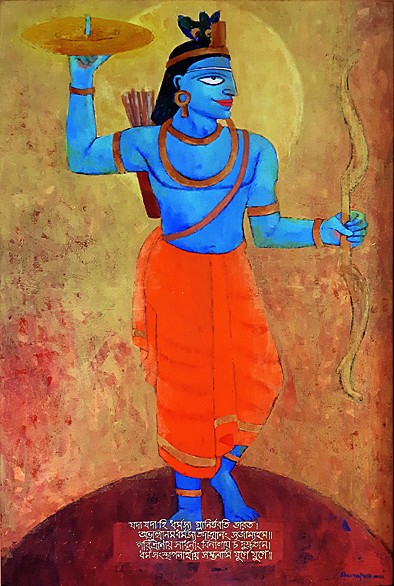The seduction of the Mahabharata is that, as Saoli Mitra’s play, Naathabati Anaathbat, reminds the audience, ‘juge juge hoe tar notun bykhan’ (in every age there unfold/ new meanings from the old). The epic has thus captured the contemporary urban imagination ever since it was rediscovered by modern-day hermeneutics. The most recent re-teller is Subhaprasanna, whose series, The Mystique of the Epic, was seen at the Kolkata Centre for Creativity recently.
This blockbuster, which is how Umberto Eco describes the Old Testament, could give the Hebrew text more than stiff competition in terms of its enduring relevance since it’s obsessed neither with God nor with sins and divine punishment but with dilemmas and debates. It etches characters with unsparing psychological insights to dissect, clinically, the inexorable pitfalls of human passions. But it throws up a problem for miners of the myth: should it be treated as an episodic romance in a period mise-en-scene, or a tale meant for raconteurs, with words left to weave indefinable, ambiguous suggestions for different listeners?
Subhaprasanna chooses the first option, not surprising for a visual artist. He employs his considerable skills to illustrate incidents and characters somewhat in the earnest spirit of the neo-classicists depicting heroic legends of Greco-Roman antiquity literally rather than metaphorically. However, unlike the latter, his figuration is stylized, and scales are a matter of the artist’s personal view rather than visual logic. For example, Shantanu, Parashar and Dhritarashtra tower over Ganga, Satyabati and Gandhari, perhaps as a visual device, though the role of the women characters in propelling the story forward can’t be overstated.
The artist picks a few turning points as his themes: Arjun aiming his arrow at the overhead target at King Drupad’s court; the disrobing of Draupadi; Karna and his mother Kunti — the subject of Tagore’s masterly “Karna-Kunti Sangbad” — his slaying in battle; Bhishma lying on a bed of arrows; and so forth. Colourful and dramatic in an earthy, accessible idiom, such a series would be ideal for accompanying a live narration in the tradition of chitrakars, while the multi-level ellipses between one episode and another can be filled in by the informed.










